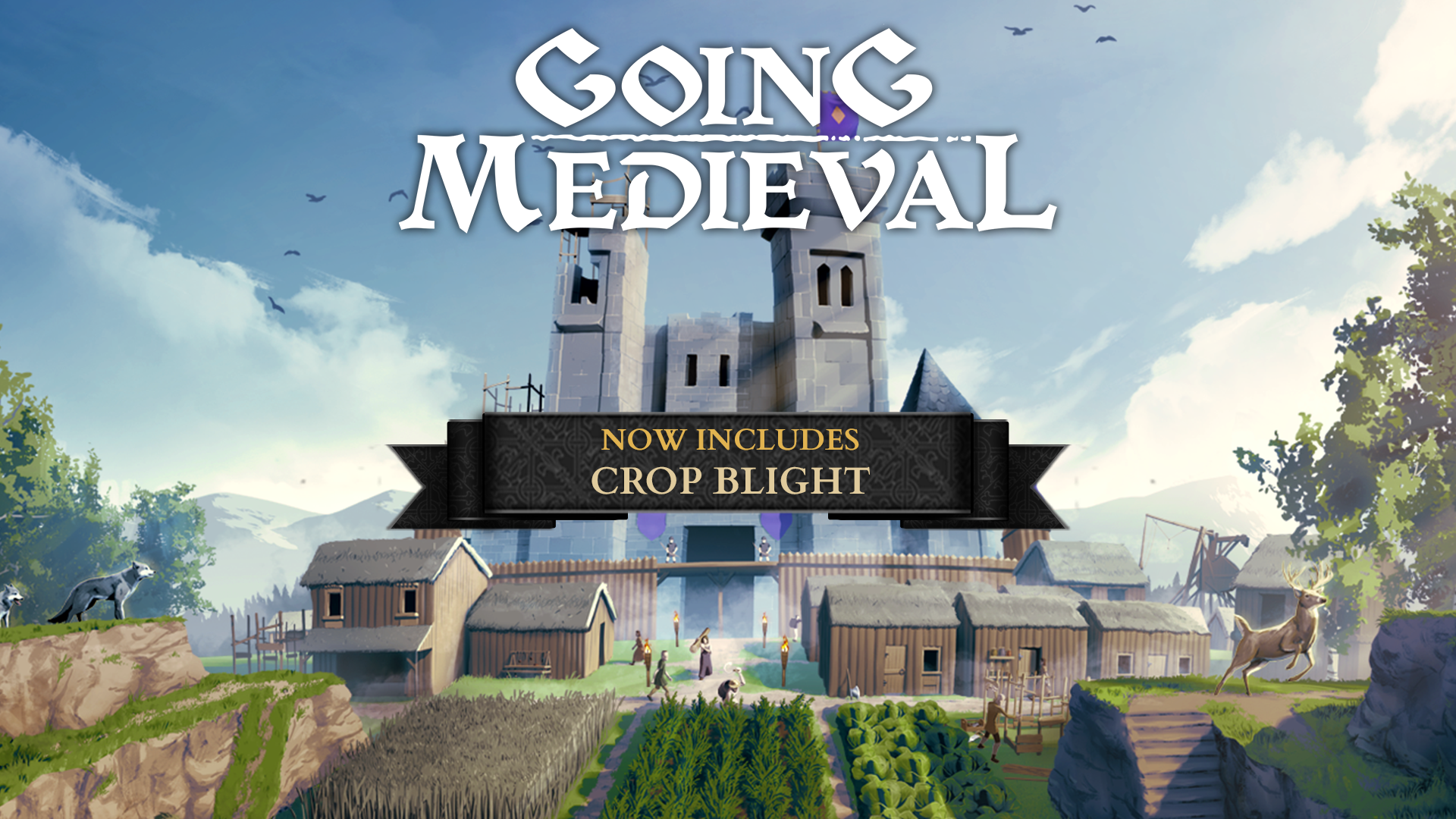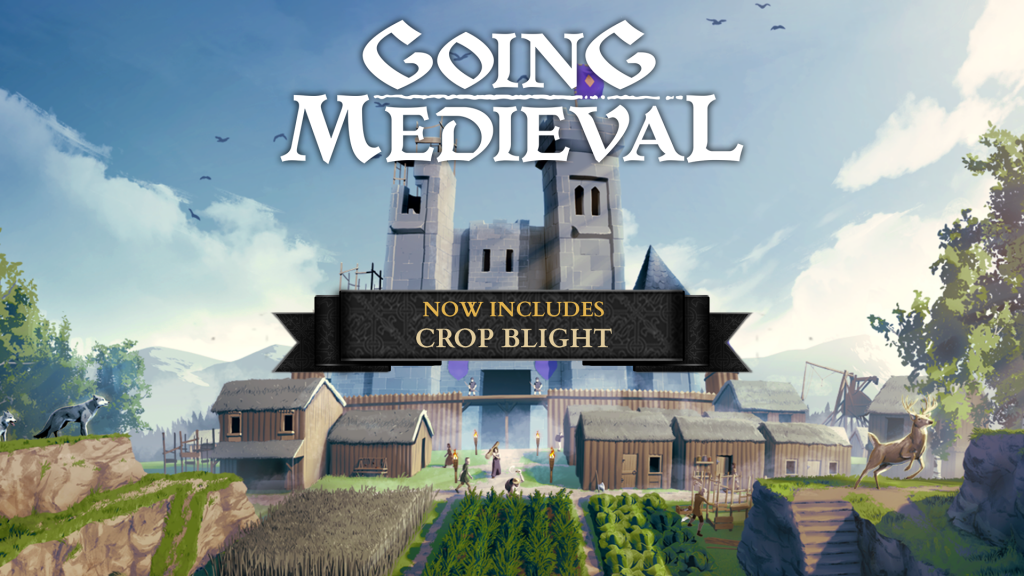Greetings, medievalists!
The new major update titled “New Resources & Cultivation” is now live on Steam, Epic Games Store, and GOG. It include new resources, new buildings, more harvesting options, fueling system, new settler’s modifiers and various other tweaks and improvements.
Watch the video below to see the update’s highlights, and if you want to go into more detail, beneath the video are the full patch notes:
Now, onto the updates:
Seeds and Saplings
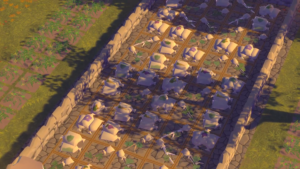
We have made some major changes to crops. You won’t be able to magically conjure them from thin air anymore and we’ve added a new phase to the life cycle of plants. Saplings are also in the game. Here is how it’s all going to work:
- To sow crops, you will need new resources – seeds and saplings.
- Agriculture now unlocks all crop fields, but they will not appear in the crop field panel unless you have the seed for that crop somewhere on the map.
- One seed/sapling occupies one grid space.
- One settler can carry a maximum of 300 seeds | 30 saplings in their inventory.
- Some crops, like barley and redcurrant, are sown with their produce (one redcurrant, as a resource is used to plant one redcurrant bush).
- All plants drop seeds in their ripe phase, but there are certain plants like cabbages, carrots, and beets, that give more when in flowering and seeding phases.
- Trees drop saplings whenever they are cut, except when in the dead phase.
Crop Blight
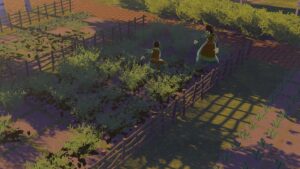
Blight is the new event in the game and will appear during summer and autumn. It will occasionally occur on random sections of the field and will destroy your crops if it isn’t dealt with.
- Blight can affect only flax, barley, cabbage, carrots, and beets.
- When the blight appears, you will want to cut contaminated crops before it’s too late, as it will spread to nearby crops.
- Strategic crop placement will also prevent the blight from spreading – the size of the crop fields, as well as their shapes, play a big role in blight control.
New flora
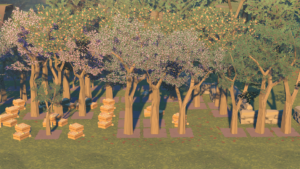
To make things a little easier and interesting, we added some new flora elements.
- Apple trees are added to the game and can be sown with apple saplings. You can’t find those saplings in the wild, but they can be bought from merchants or settlements. These trees have several harvest cycles and produce apples, wood, and sticks.
- Wild flax and wild barley are here (or, as we’d say it: growing wild!). Look at them as a starting point from which you will obtain seeds. They look a bit different and give fewer resources than regular flax and barley.
- Even if your scenario starts with zero wild flax and barley, over time they should appear all over the map. The amount will depend on the map type and size.
New resources
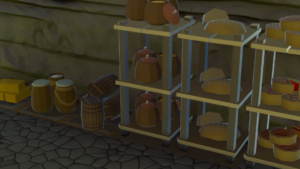
With the latest update, we are bringing some useful new resources that can be utilized across your settlement.
- Bread – produced as a meal if you use barley as a singular cooking resource.
- Apple pie – produced as a meal if you use apples as a singular cooking resource.
- Redcurrant pie – produced as a meal if you use redcurrants as a singular cooking resource.
- Honey crisps – produced as a meal if you use honey as a singular cooking resource.
- Apple cider – produced from using apples in the brewing station.
- Mead – produced from using honey in the brewing station.
- Honey – produced from skeps. It can be eaten raw, used for cooking and used as a basic medkit (like herbs.)
- Wax – produced from skeps. Used to refuel candles.
- Tallow – produced when butchering some animals. Also used as a basic medkit (like herbs). Can also be used to refuel candles.
- Ice blocks – made from ice boxes. They can only be produced if the temperature around them is -1 or less. Ice blocks lower the temperature of the room around them when stored in any room.
- Silver – mined from voxels.
- Silver ingots – made from silver in the smelting station, like other ingots.
New equipment
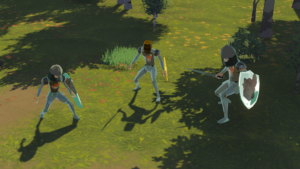
We’ve added new weapon materials for you and your enemies:
- Silver versions of weapons, armors, and shields are in the game. When it comes to quality for weapons, silver is a bit better than gold, but still worse than iron or steel. Silver items have a greenish tint to them, so they look like rusted silver. It’s a design choice to make them different from gold, iron, and steel.
- Bucklers, kite, and regular shields now have all-metal variations (gold, steel, iron, and silver.)
- Enemies and visitors have some new equipment that you can’t create. Things like armor made from bones, animal headpieces, headbands, etc. Nothing stops you from taking those forcefully, though.
New structures
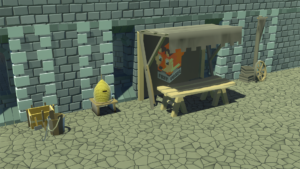
New production buildings, as well the ones that are going to make trading easier, are now in the game.
- Icebox – produces ice blocks. Temperature around the structure influences the speed of production. The production will stop when the temperature becomes higher than -1. The lower the temperature, the faster the production.
- Skep – produces honey and wax. Skeps are also influenced by temperature and will not produce if the temperature is too low.
- Merchants stall – merchants will go to this structure once they appear on your map. Their goods will appear on the stall when they reach it, and you will be able to start the trading process either by the right-clicking merchant or the stall.
- Caravan Halt – settlers will gather at this structure when forming a caravan. Forming caravans also works as before. When settlers return, the resources will spawn around the nearest halt instead of on the edge of the map.
Visual variations to structures
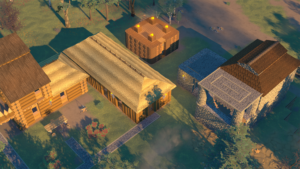
You can now change visual variations to some structures. NOTE: This type of change will have no impact on gameplay. It only impacts the visuals of the game.
- Elements that have variations are: roofs, walls, floors, fences, merlons.
- Beyond shape variations, roofs now have material variations, too. These are strictly visual differences.
- By using a rotation of these variations, only the visual representation will be affected.
- Corner merlons and corner fences are included as variations of merlons/fences now.

Research panel changes
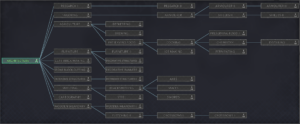
The research panel had to be reorganized a bit due to the integration of the elements mentioned above.
- Beekeeping and Ice Making research nodes are now in the research panel – unlocking these nodes will allow you to build Skeps and Ice Boxes.
- The research panel received a bit of visual rearrangement due to the integration of these elements.
New harvesting control and behavior
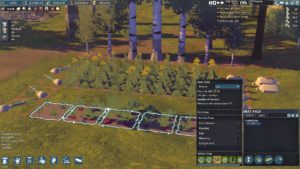
Crop fields have an additional panel next to the selection panel now. Within that panel there are a couple of options that you can select:
- Crop field priority – You can change the priority of crop fields, just like you do with stockpiles. All crop fields with the same priority will be treated the same as before (the closest one has the highest priority). Priority influences sowing, cutting, and harvesting.
- Don’t Sow – Settlers will still harvest the existing crops on the field but will not sow another round while this box is checked.
- Harvest Phase – You can now choose in which phase a crop gets harvested. The phases you can choose are only phases where a harvestable resource is present (note that barley plants only have one harvest phase.)
- Cutting Phase – This option appears when you select tree crops. Some trees, like apple trees, have both cutting and harvesting phases within this panel.
- Changing crops – You can change the type of crops that are sown on the selected field. Changing a crop type will order the crops on that field to be cut down so the new ones can be sown.
Other notable changes in this area:
- Plants now die if they are under a roof. A message will appear in a plant’s selection screen when this happens. If you place crop fields under the roof, it will not trigger settlers to sow there
- Resource amount dropped after harvesting/cutting is now multiplied by the percentage of HP the plant has. For example: if the hailstorm, frost, or blight hurts the plants, they will give fewer resources because of it.
Fuel system
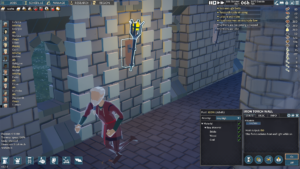
Light and heat sources now require refueling in order to emit heat/light. Once these buildings are out of fuel, settlers will need to use one of the fuel types to refill them.
- Structures like braziers, torches, and candles need refueling to emit heat.
- Each structure can have a different kind of fuel. Torches and braziers use coal, wood, and sticks, while candles use tallow and wax.
- Each fuel resource has an assigned fuel strength, meaning they will not offer the same fuel amount. More tallow is needed than wax to refuel a candle. You will also need more sticks than coal or wood.
- Settlers that have the Steward job turned on will do the refueling.
- Once refueled, those buildings can be turned on/off without settlers.
The fuel system is used on furniture that gives heat (braziers, candelabra, torches). We are not using them on production buildings (even though they give off heat as well).
New modifiers for settlers
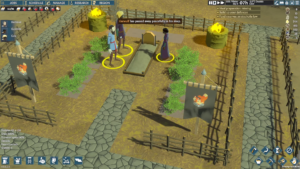
Settlers now have different modifiers as they age (some of the attributes are different if they are young, adult, middle-aged, or senior). These modifiers are also affected by the settler’s height and weight.
- Settlers gain random perks (sometimes) when they have a birthday. The perk is given in the same rule set as randomizing a settler when creating them.
- Some perks (for now only the cannibal perk) can’t be received with birthdays.
- Settlers can now die of old age. Every time it’s time for them to wake up (if they are older than 65 and after at least 3h of sleep) there is a chance they will die. As they grow, their chances of dying will increase. If you really want to see the odds and edit them, you can do so within the WorkerBase.json file.
The rebellious state and merry modifiers have been changed.
- Rebellious – Before, when a settler’s mood would drop under a certain threshold, the settler would become rebellious. Now, when the mood drops under a certain threshold, there is a 50% chance the settler will become rebellious, with each negative mood modifier that happens. There is a cooldown where the settler can’t become rebellious sometime after being rebellious.
- Merry – Before, while a settler’s mood was over 80%, the settlers were merry by default. Now, when the mood is over 80% settlers have a 50% chance of getting the merry effector, with every good mood modifier that triggers.
Settlers are dreaming.
- Settlers can now have good or bad dreams. (there is also a chance they do not dream.)
- Settlers that have some perks, like glutinous, cannibal, and bloodlust can also have different dreams.
- Settlers with the bloodlust perk now get a mood modifier when killing someone.
Enemies
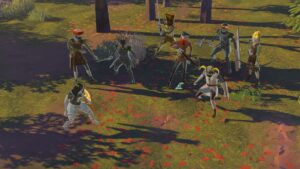
Enemies now have new equipment that relates to the factions they are tied to – this is an aesthetic choice as we think it adds a bit more personality to the factions.
- Shields and plate armors now have heraldry on them. They will have the enemy heraldry while the enemy has them equipped and the player’s heraldry while the player has them equipped.
- Factions now have a percentage of female visitors and/or enemies.
Music:
New songs, yay!
- Added two music tracks and changed music playlist logic.
Other notable introductions and improvements
- The Animal Husbandry job type has been added to the JOBS panel. At the moment, it is only used for beekeeping.
- The camera will not move to the merchant location once the event appears in the game.
- Clay brick and Limestone Brick arches are in the game, due to the popular demand
- The Bartering and Caravan screen has sorting arrows now – you can sort items by alphabetical placement, value, amount, etc.
- Non-tradable items will be always at the bottom of the screen by default.
- We’ve introduced daily maximum attainable level experience for a skill per settler. On a daily basis, settlers will be able to earn 1600XP for one skill. If that number is passed, the settler will earn 10% of the XP for that skill (meaning, if they earned 50XP for cutting trees, now they’ll earn 5XP). When the day starts anew, XP that was 1600/1600 will return to 0/1600. The cap limit is influenced by various factors, so settlers will differentiate among themselves. We also introduced skill decay – once a settler reaches level 5 with a skill, XP for those will start to decay. Decay will be slower but over time, as settlers age, decay numbers will increase. Decay will not affect their current skill level – skill level cannot decay under the last level gained.
- A new tooltip system has been implemented. Tooltips should no longer stay active on the screen and appear dubbed from time to time. Tooltips will now follow the mouse cursor in order to look a bit more fluid.
- World layer level is now written in the save data – upon loading, the game will remember the layer on which you were on.
And we’ve also fixed a bunch of things!
Thank you for being with us, people. Feel free to post your experience regarding the new update on Steam discussions. If you want more dynamic/direct communication – head over to our Discord server. Even though we might not reply, we are reading everything.
Stay medieval!
